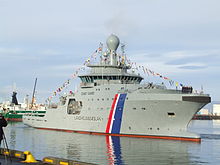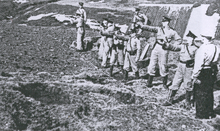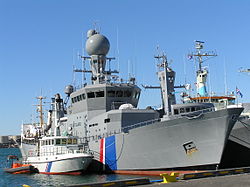- Military of Iceland
-
Military of Iceland 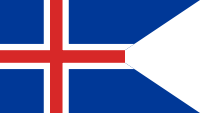
Service branches Icelandic Coast Guard
Iceland Air Defence System
Iceland Crisis Response UnitLeadership Minister for Foreign Affairs Össur Skarphéðinsson CEO of the Icelandic Coast Guard R.adm Georg Lárusson Manpower Available for
military service74,896, age 16-49 Fit for
military service62,576 males, age 16-49,
61,159 females, age 16-49Reaching military
age annually2,369 males,
2,349 femalesActive personnel 270 (2011) Expenditures Percent of GDP 0.4% of GDP (2008) Related articles History Military history of Iceland Icelands defences consist of the Icelandic Coast Guard which patrols Icelandic waters and airspace and other services such as the National Commissioner's National Security and Special Forces Units.[1][2][3][4] Iceland is however the only NATO member which maintains no standing army, although there is no legal impediment to forming one and Icelandic services perform the operations fellow NATO allies relegate to their standing armies.
The Coast Guard consists of three ships and four aircraft and armed with small arms, naval artillery, and Air Defense weaponry. The Coast Guard also maintains the Icelandic Air Defense System, formerly part of the disestablished Defence Agency, which conducts ground surveillance of Iceland's air space.
Units subordinated to the National Commissioner also take part in Iceland's defences. Foremost of these are the National Security Unit, which handles intelligence operations and the special unit Víkingasveitin, a highly trained and equipped counter terrorism unit which is part of the National Police force.
Additionally there is a Crisis Response Unit (ICRU), operated by the Ministry for Foreign affairs, which is a small armed peacekeeping force, that has been deployed internationally.
There is in addition, a treaty with the United States for military defenses and formerly maintained a military base, Naval Air Station Keflavik, in Iceland until September 2006, when U.S. military forces withdrew. There are also agreements about military and other security operations with Norway,[5][6] Denmark[7][8][9] and other NATO countries.
Iceland holds the annual NATO exercises entitled Northern Viking. The most recent exercises were held in 2011,[10] as well as the EOD exercise "Northern Challenge". In 1997 Iceland hosted its first Partnership for Peace (PfP) exercise, "Cooperative Safeguard", which is the only multilateral PfP exercise so far in which Russia has participated. Another major PfP exercise was hosted in 2000. Iceland has also contributed ICRU peacekeepers to SFOR, KFOR and ISAF.
The government of Iceland contributes financially to NATO's international overhead costs and recently has taken a more active role in NATO deliberations and planning. Iceland hosted the NATO Foreign Ministers' Meeting in Reykjavík in June 1987. Additionally Norway has agreed to grant Icelandic citizens the same eligibility as Norwegian citizens for military education in Norway and to serve as professional soldiers in the Norwegian Defence forces.[11]
Contents
History
Main article: Military history of Iceland An illustration of Hákon, King of Norway, and his son Magnus, from Flateyjarbók
An illustration of Hákon, King of Norway, and his son Magnus, from Flateyjarbók
In the period from the settlement of Iceland, in the 870s, until it became part of the realm of the Norwegian King, military defences of Iceland consisted of multiple chieftains (Goðar) and their free followers (þingmenn, bændur or liðsmenn) organised as per standard Nordic military doctrine of the time in expeditionary armies such as the leiðangr. The armies being divided into units by the quality of the warriors and by birth. At the end of this period the number of chieftains had diminished and their power had grown to the detriment of their followers. This resulted in a long and bloody civil war known as Sturlungaöld. The average battle consisted of little less than 1000 men.
Amphibious operations were important part of warfare in Iceland in this time, especially in the Westfjords, but large naval engagements were not common. The largest of which was an engagement of a few dozen ships in Húnaflói known as Flóabardagi.
In the decades before the Napoleonic wars, the few hundred militia-men in the southwest of Iceland were mostly equipped with rusty and mostly obsolete medieval weaponry, including 16th century halberds. When English raiders arrived in 1808, after sinking or capturing most of the Danish-Norwegian Navy in the Battle of Copenhagen, the amount of gunpowder in Iceland was so low that it prohibited all efforts of the governor of Iceland, Count Trampe, to provide any resistance.
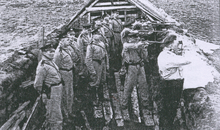 Officers of the defence force in a trench on Vaðlaheiði in 1940.
Officers of the defence force in a trench on Vaðlaheiði in 1940.
In 1855, the Icelandic Army was re-established by Andreas August von Kohl the sheriff in Vestmannaeyjar. In 1856, the king provided 180 rixdollars to buy guns, and a further 200 rixdollars the following year. The sheriff became the Captain of the new army, which become known as Herfylkingin, "The Battalion." In 1860 von Kohl died, and Pétur Bjarnasen took over the command. Nine years later Bjarnasen died before appointing a successor, and the army fell into disarray.
In 1918 Iceland regained sovereignty as a separate Kingdom ruled by the Danish king. Iceland established a Coast Guard shortly after, but financial difficulties make establishing a standing army impossible. The government hoped that a permanent neutrality would shield the country from invasions. But at the onset of Second World War, the government, being nervous, decided to expand the capabilities of the Icelandic National Police (Ríkislögreglan) and its reserves into a military unit. Chief Commissioner of Police Agnar Kofoed Hansen had been trained in the Danish Army and he moved to train his officers. Weapons and uniforms were acquired, and they practiced rifleshooting and military tactics near Laugarvatn. Hansen barely managed to train his 60 officers before the United Kingdom invaded Iceland on 10 May 1940. The next step in this army building move was to train the 300 strong reserve forces, but the invasion effectively stopped it.
See also: History of IcelandCoast Guard
Icelandic Coast Guard vessels. Týr in the center. Main article: Icelandic Coast Guard
Main article: Icelandic Coast GuardShortly after Iceland reclaiming its sovereignty in 1918, the Icelandic Coast Guard was founded. Its first vessel, a former Danish research vessel, was armed with a 57 mm cannon. The Coast Guard is responsible for protecting Iceland's sovereignty and vital interests such as the most valuable natural resource—its fishing areas—as well as provide security, search, and rescue services to Iceland's fishing fleet. In 1952, 1958, 1972, and 1975, the government expanded Iceland's exclusive economic zone to 4, 12, 50 and 200 nautical miles (370 km) respectively. This led to Iceland's conflict with the United Kingdom, known as the "Cod Wars". The Icelandic Coast Guard and the Royal Navy confronted each other on several occasions during these years. Although few rounds were fired, there were many intense moments between the two nations. Today the Coast Guard remains Iceland's premier fighting force equipped with armed patrol vessels and aircraft and partaking in peacekeeping operations in foreign lands.
Iceland Air Defence System
Main article: Iceland Air Defence SystemThe Iceland Air Defence System or Íslenska Loftvarnarkerfið was founded in 1987, and operates four radar complexes, a software and support facility and a command and report centre. It is a part of the Coast Guard.
Iceland's NATO allies also regularly deploy fighter aircraft to patrol the country's airspace as part of the Icelandic Air Policing mission.[12]
Icelandic Crisis Response Unit
Main article: Icelandic Crisis Response UnitThe Icelandic Crisis Response Unit (ICRU) (or Íslenska friðargæslan or "The Icelandic Peacekeeping Guard") is an expeditionary peacekeeping force maintained by the Ministry for Foreign Affairs. It is manned by various personnel from Iceland's other services, armed or not, including the National Police, Coast Guard, Emergency Services and Health-care system. Because of the military nature of most of the ICRU's assignments, all of its members receive basic infantry combat training. This training has often been conducted by the Norwegian Army, but the Coast Guard and the Special forces are also assigned to train the ICRU.
Most of the ICRU's camouflage and weaponry is procured from abroad, with some indigenous development. Some arms and uniforms are also borrowed from the Norwegian Defence Forces.
The formation and employment of the unit has met controversy in Iceland, especially by people to the left on the political scale. In October 2004 three ICRU soldiers were wounded in a suicide bombing in Kabul. The incident led to tough questioning of the group's commander, Colonel Halli Sigurðsson, focusing on his conduct[citation needed]. He was later replaced by Colonel Lárus Atlason.
ICRU missions
The ICRU has or is operating in:
- Military missions:
 Afghanistan within ISAF
Afghanistan within ISAF Iraq within NTM-1 (and the Coast Guard within Dancon/Irak)
Iraq within NTM-1 (and the Coast Guard within Dancon/Irak) Serbia/
Serbia/ Kosovo within KFOR
Kosovo within KFOR
- Civilian missions:
 Bosnia and Herzegovina within EUPM
Bosnia and Herzegovina within EUPM Lebanon within MACC-SL
Lebanon within MACC-SL Sri Lanka within SLMM
Sri Lanka within SLMM
List of small-arms used by Icelandic forces
 /
/ Heckler & Koch G3/AG-3 battle rifle
Heckler & Koch G3/AG-3 battle rifle Heckler & Koch MP5 submachine gun
Heckler & Koch MP5 submachine gun Heckler & Koch G36 Assault rifle
Heckler & Koch G36 Assault rifle Glock 17 pistol
Glock 17 pistol Steyr SSG 69 sniper rifle
Steyr SSG 69 sniper rifle Blaser R93-7.62×51 NATO sniper rifle
Blaser R93-7.62×51 NATO sniper rifle Mossberg 500 shotgun
Mossberg 500 shotgun Rheinmetall MG3 medium machine gun
Rheinmetall MG3 medium machine gun Browning M2 machine gun
Browning M2 machine gun M14 rifle
M14 rifle Diemaco C8 assault rifle
Diemaco C8 assault rifle
Sources
- ^ Varnarmálastofnun Íslands.
- ^ Lög um breytingu á varnarmálalögum, nr. 34/2008.
- ^ Varnarmálalög.
- ^ Landhelgisgæsla Íslands Hlutverk.
- ^ A press release from the Norwegian Ministry of Foreign Affairs.
- ^ An English translation of the Norwegian-Icelandic MoU at the website of the Norwegian Ministry of Foreign Affairs.
- ^ Norway Post: Norway and Iceland to sign defence agreement
- ^ Aftenposten: Norway to help defend Iceland
- ^ Danmarks Radio
- ^ A press release from the Icelandic Coast Guard.
- ^ Norwegian Defence Forces: Alle gode ting er tre
- ^ "Air Policing". NATO Air Command Operations. http://www.aco.nato.int/page142085426.aspx. Retrieved 2 October 2010.
- Birgir Loftsson, Hernaðarsaga Íslands : 1170-1581, Pjaxi. Reykjavík. 2006..
- Þór Whitehead, The Ally who came in from the cold : a survey of Icelandic Foreign Policy 1946-1956, Centre for International Studies. University of Iceland Press. Reykjavík. 1998.
- Icelandic Coast Guard.
- Icelandic National Police.
- Iceland Air Defence System.
- Ministry of Justice and Ecclesiastical Affairs.
- Ministry for Foreign Affairs.
See also
- Cod Wars
- List of countries without armed forces
- List of countries by military expenditures
- List of countries by number of active troops
- List of countries by size of armed forces
Links
-
Law enforcement in Iceland North Atlantic Treaty Organization (NATO) History 
Structure Members Military of Europe Sovereign
states- Albania
- Andorra
- Armenia
- Austria
- Azerbaijan
- Belarus
- Belgium
- Bosnia and Herzegovina
- Bulgaria
- Croatia
- Cyprus
- Czech Republic
- Denmark
- Estonia
- Finland
- France
- Georgia
- Germany
- Greece
- Hungary
- Iceland
- Ireland
- Italy
- Kazakhstan
- Latvia
- Liechtenstein
- Lithuania
- Luxembourg
- Macedonia
- Malta
- Moldova
- Monaco
- Montenegro
- Netherlands
- Norway
- Poland
- Portugal
- Romania
- Russia
- San Marino
- Serbia
- Slovakia
- Slovenia
- Spain
- Sweden
- Switzerland
- Turkey
- Ukraine
- United Kingdom
- Vatican City
States with limited
recognition- Abkhazia
- Kosovo
- Nagorno-Karabakh
- Northern Cyprus
- South Ossetia
- Transnistria
Other entities - European Union
- Sovereign Military Order of Malta
Categories: - Military missions:
Wikimedia Foundation. 2010.

